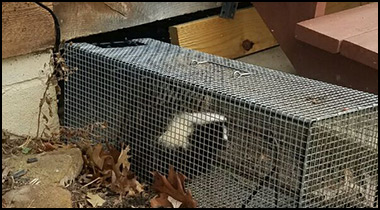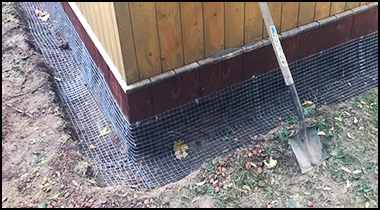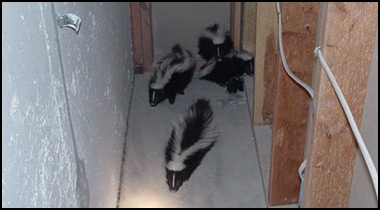Olympia Skunk Removal Resources
Skunk Rehabber - South Sound Wildlife Rehab Center: (360) 866-8367
Free Thurston County Animal Services: (360) 352-2510
Humane Wildlife Trappers of Olympia: 360-539-8266
If you need skunk control in Olympia, you have a few options. First, you can attempt to solve the skunk problem yourself by reading our do-it-yourself guide. If you need outside help, you can also call Thurston County Animal Services to see if they have any free resources or help for you - however, they primarily deal with dog and cat concerns. You can also call a local Olympia wildlife rehabber, as they are typically a great resource for advice that is in the best welfare of the animal. If as a last resort you must hire a professional company, we recommend Humane Wildlife Trappers of Olympia at 360-539-8266. To learn more about them or check their skunk removal prices, visit olympiapestanimal.com.

Olympia Skunk Trapping and Removal

Preventative Repairs & Exclusion

Olympia Skunk Removal From Structures
In many cases, preventative measures can solve your Olympia skunk problem - keep garbage secured, pet food indoors, and most of all when it comes to skunks, secure the perimeter of your shed, porch, deck, or house with a barrier - lattice or steel mesh is good, and it keeps Washington skunks from going under the structure. If trapping and removal of the skunk is the only option you have, please do so with the help of a local agency or professional company who knows how to do it humanely and legally. Browse the resources of this site for more educational information.
Frequently Asked Questions:
Prevention: How to Keep Skunks Away
What to do with a skunk after I catch it?
Is it legal for me to trap a skunk?
How to remove skunk odor
Is a skunk active during the daytime rabid?
What does skunk feces look like?
Olympia Skunk Control Information: Do skunks jump?
The skunks are not able to climb or to jump and this is why you can erect the barriers around the yard if you want to keep them out. A fence of 3 feet high will be taller enough to keep the skunk away.
Skunks are known to be smelly and they are potential pests for the house that have been building around the brush and forest. When humans build into the territories of the skunks, the skunks will adapt to live near them and they will learn to live under the porches and houses while sometime they can even live in the attics. They will love to eat out of garbage and they will often travel some miles in order to raid the trash cans. When you have skunk problems, there are some steps which will eliminate these squatters.
The skunk problem will start with the food sources like the food containers and garbage cans, bird feeders and compost heaps. You can start to use trash cans with the lids to secure them. The skunks are normally nocturnal and they do not like shocking water and bright light. Use sprinkler system in your yard where the skunks enter into the lawn or hook up the single sprinkler with a motion sensor. You can use anti-skunk spray like commercial skunk repellent and pepper spray. You can spray around the boundaries of the yard and then refresh it after few days.
If it is legal in trapping the skunks in the area, you can set the box traps. Bait a trap using something that has strong smell as fish. The trap should be small so that the skunk will not raise the tail and it will not spray after it has been trapped. If the trap has already caught the skunk, you should use a towel or a blanket so that you can drive the skunk out of the town and then release it there.
The skunks are good as diggers and they will fit into small holes as far as it is bigger to 4 inches. You can keep the fence maintained and you can consider sinking them at least two feet in the soil in order to discourage the digging. Make sure that the skunks are not in the area while building this barrier. It is better to trap the skunks out and not inside of the yard. The skunks get infected with rabies so you have to keep away from them when you see them
Remember, for free services you can try (360) 866-8367 or (360) 352-2510, but if you need to pay for professional help, check the prices at the olympiapestanimal.com website. Or follow our do-it-yourself guide!

